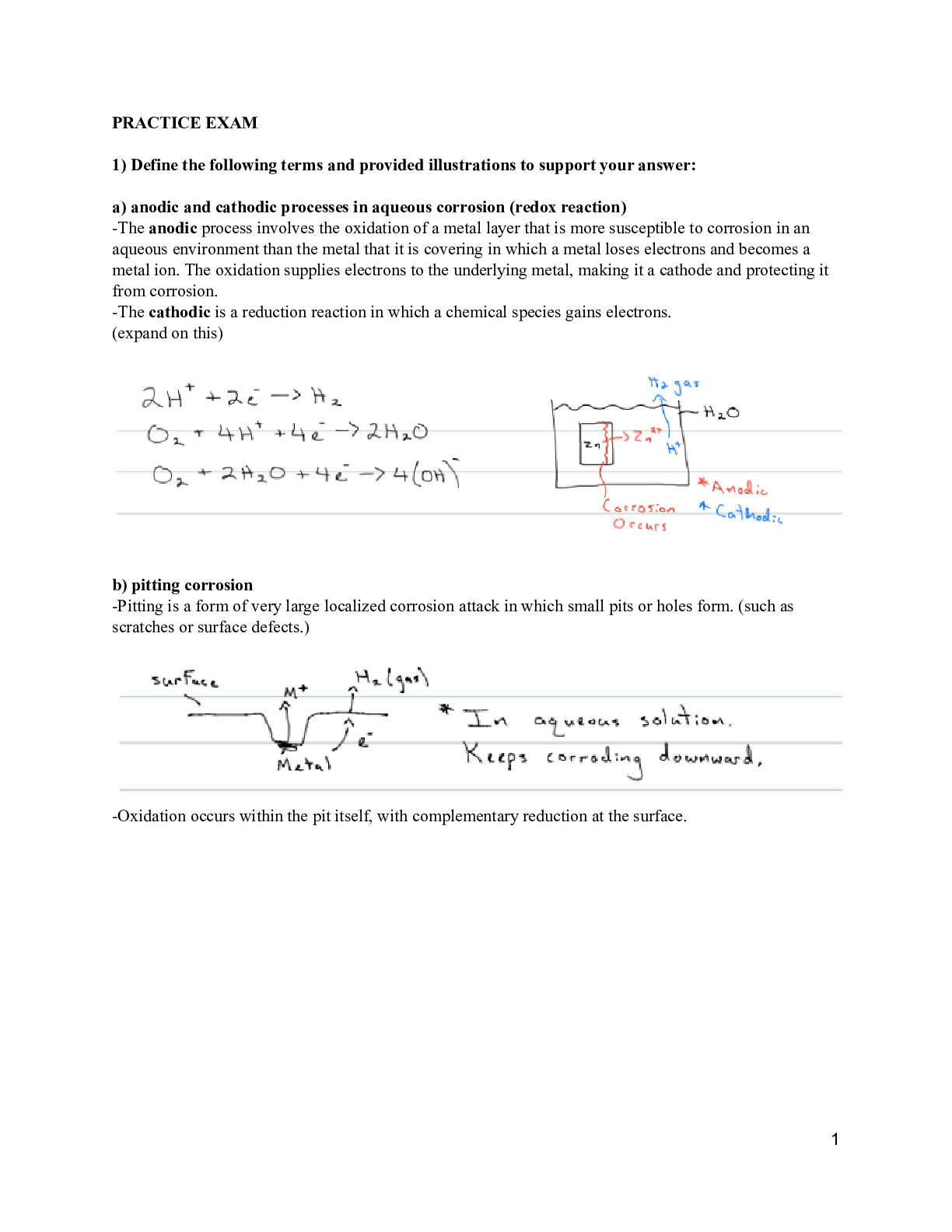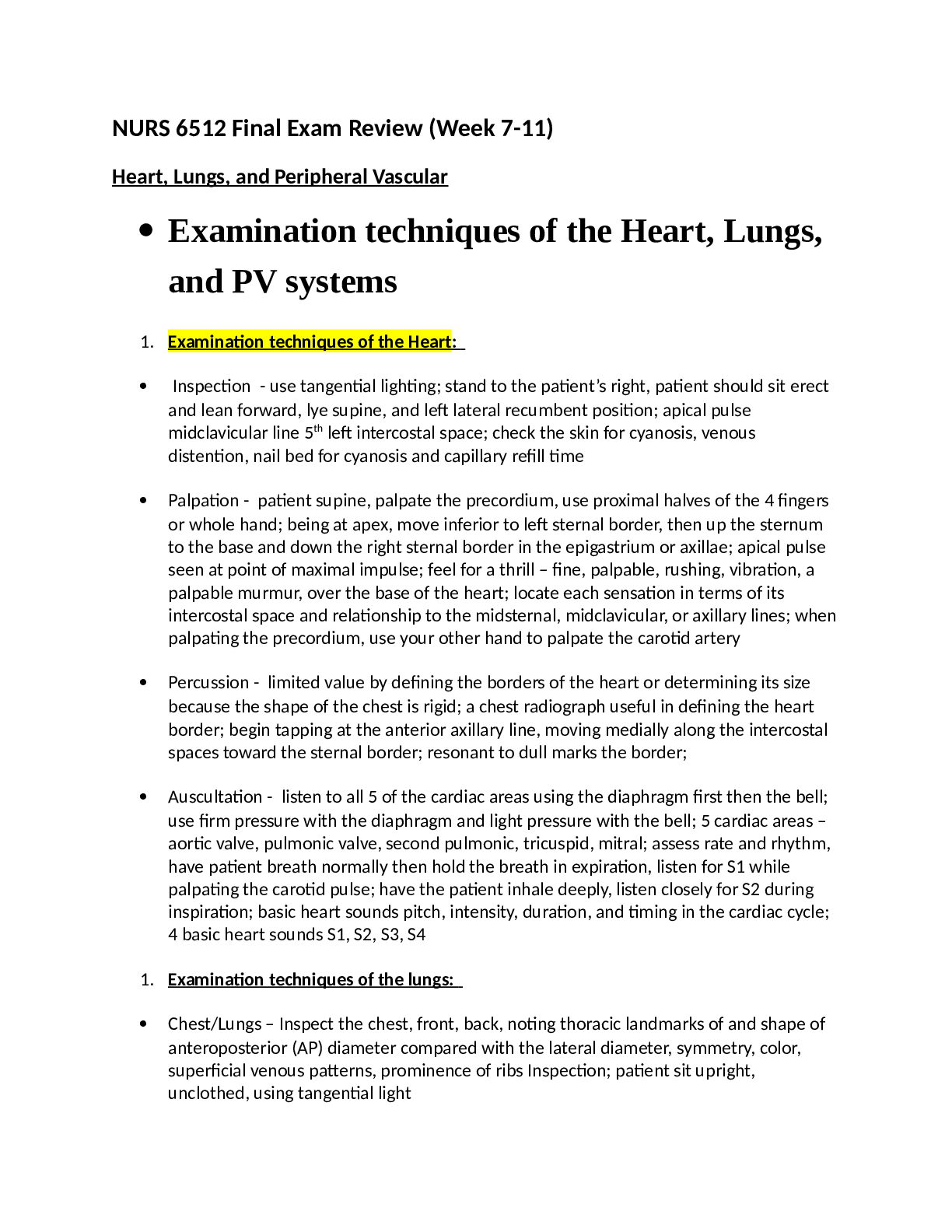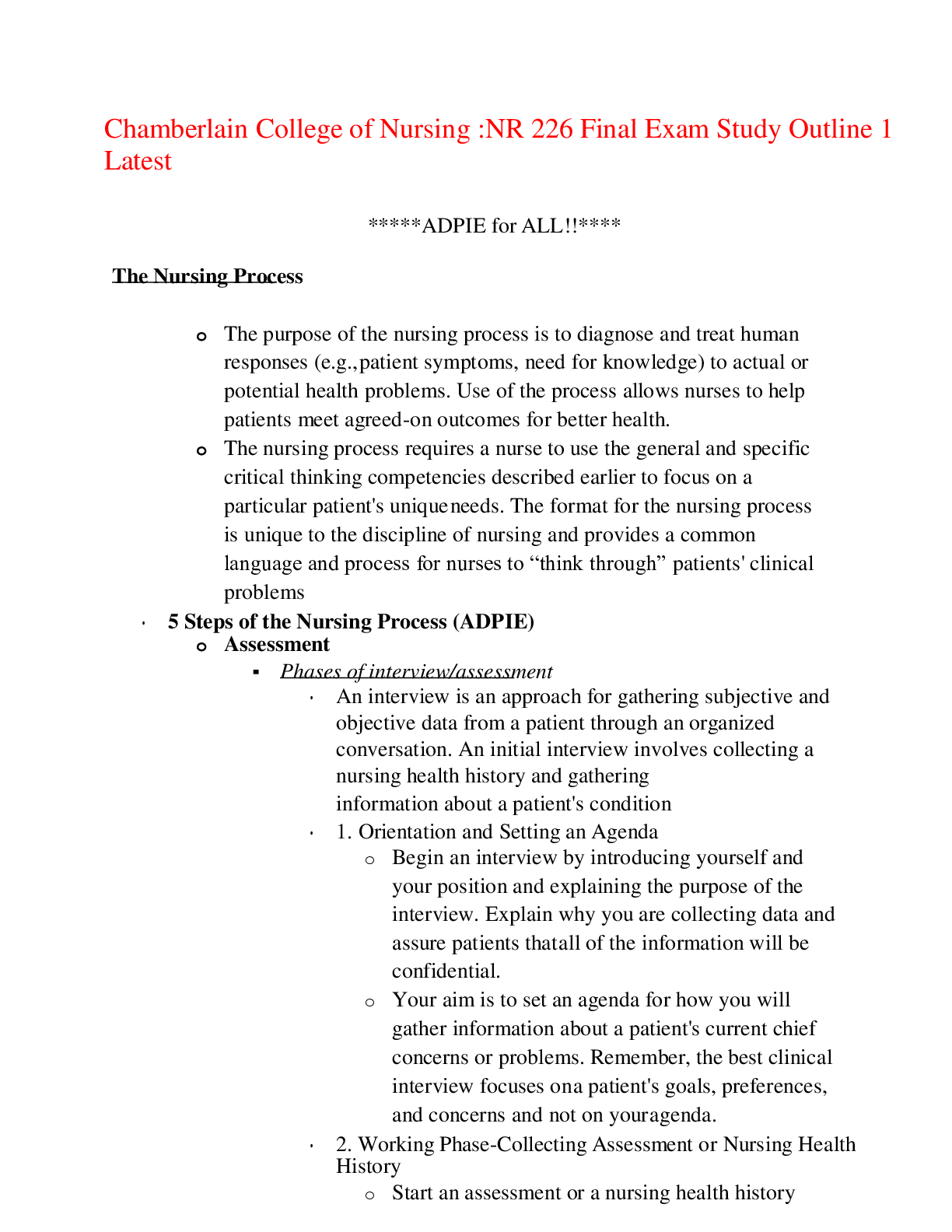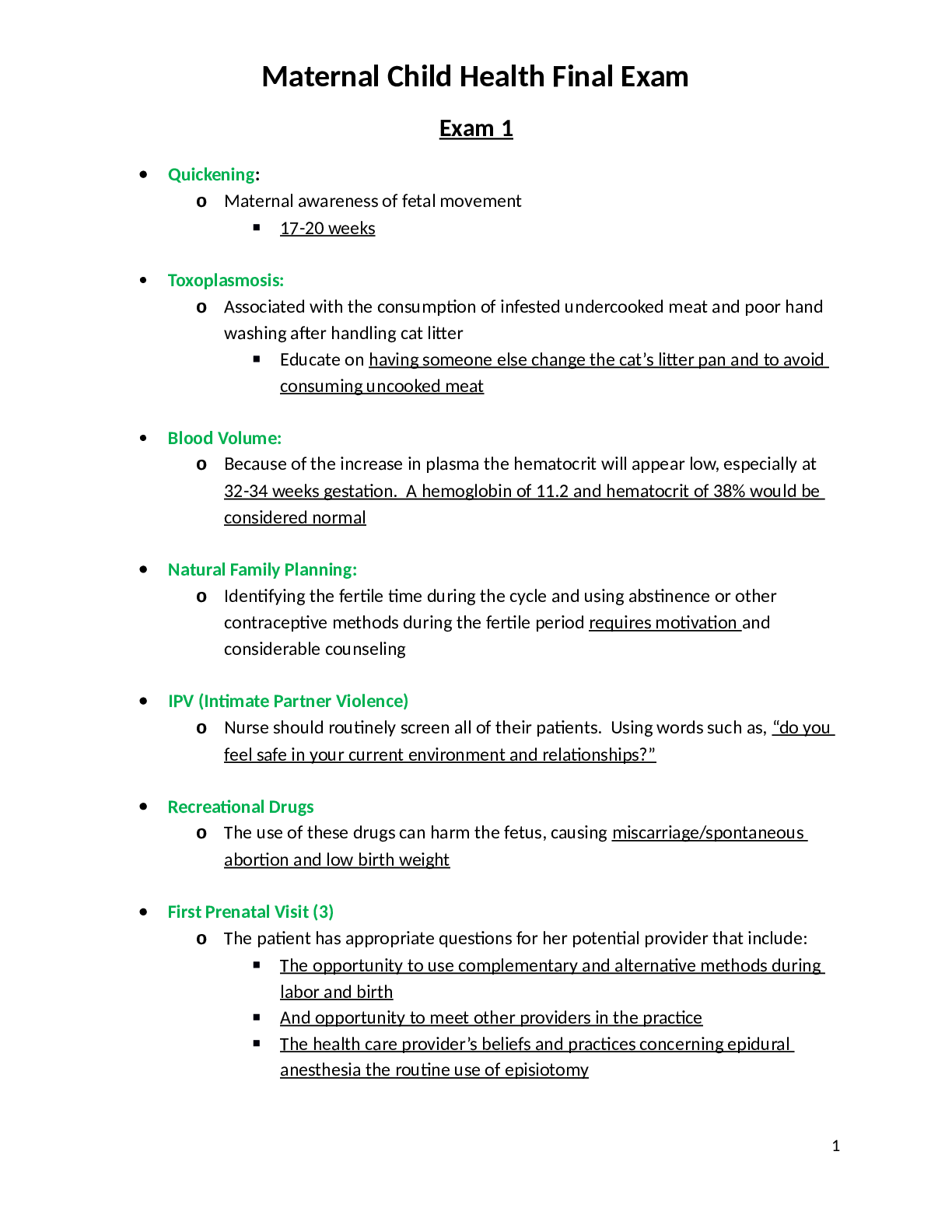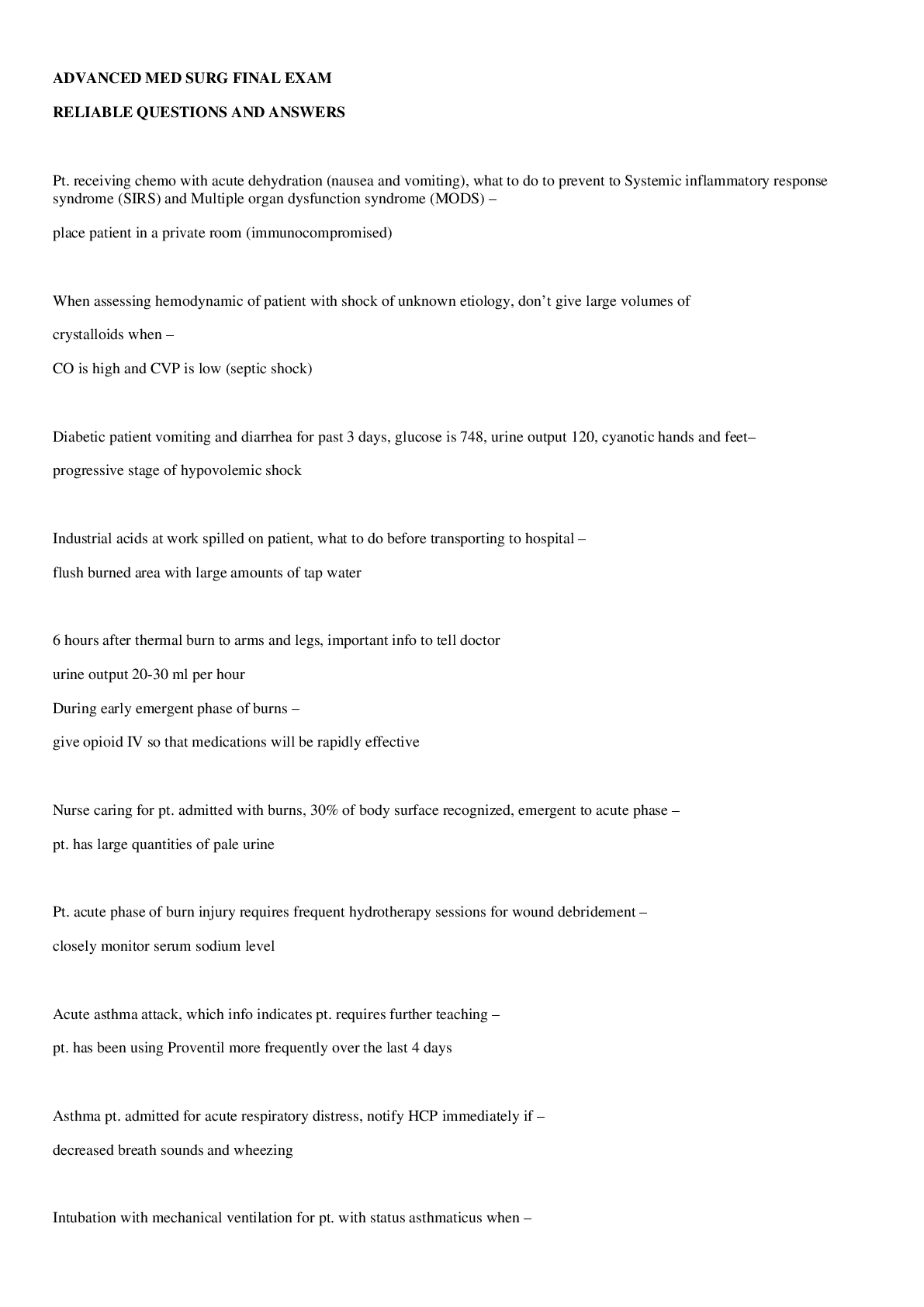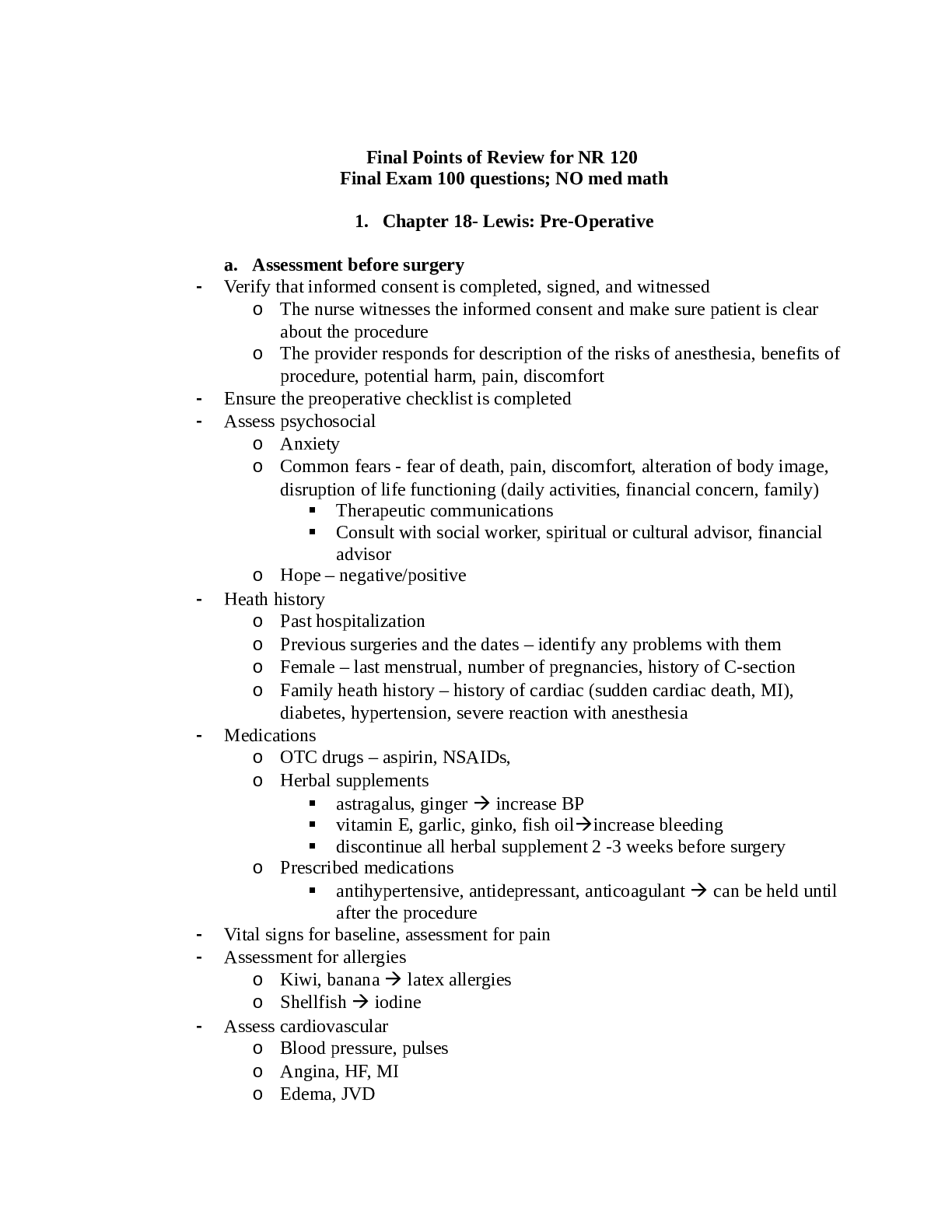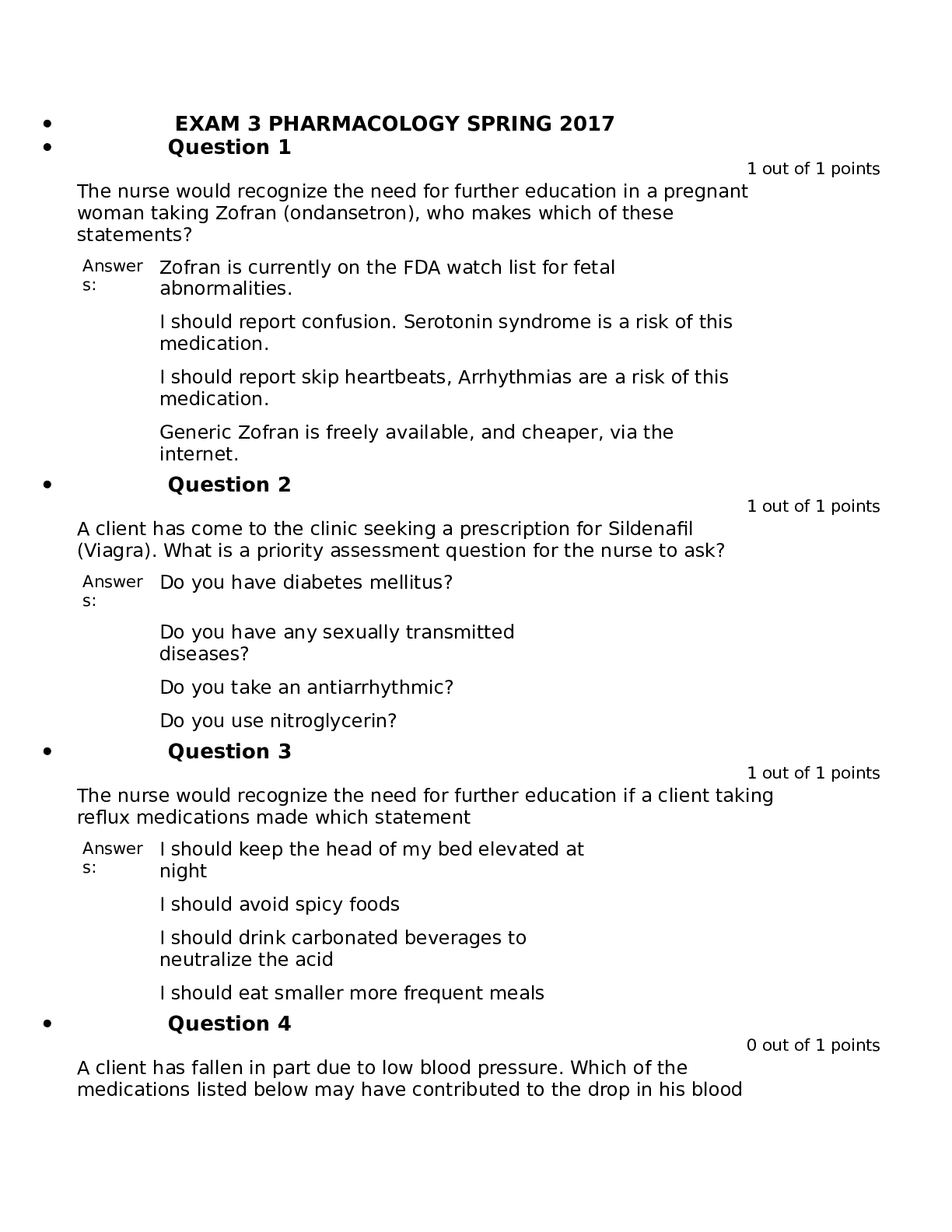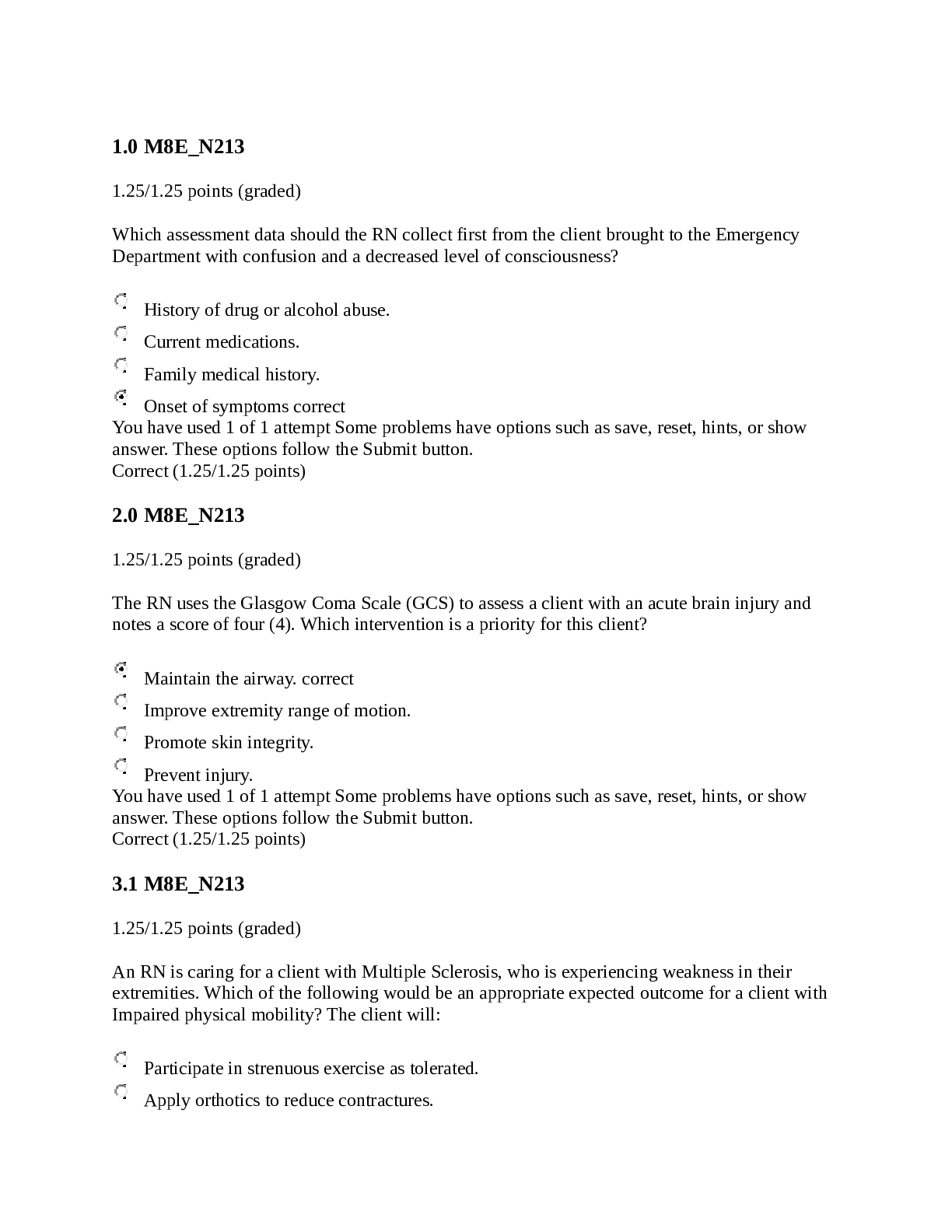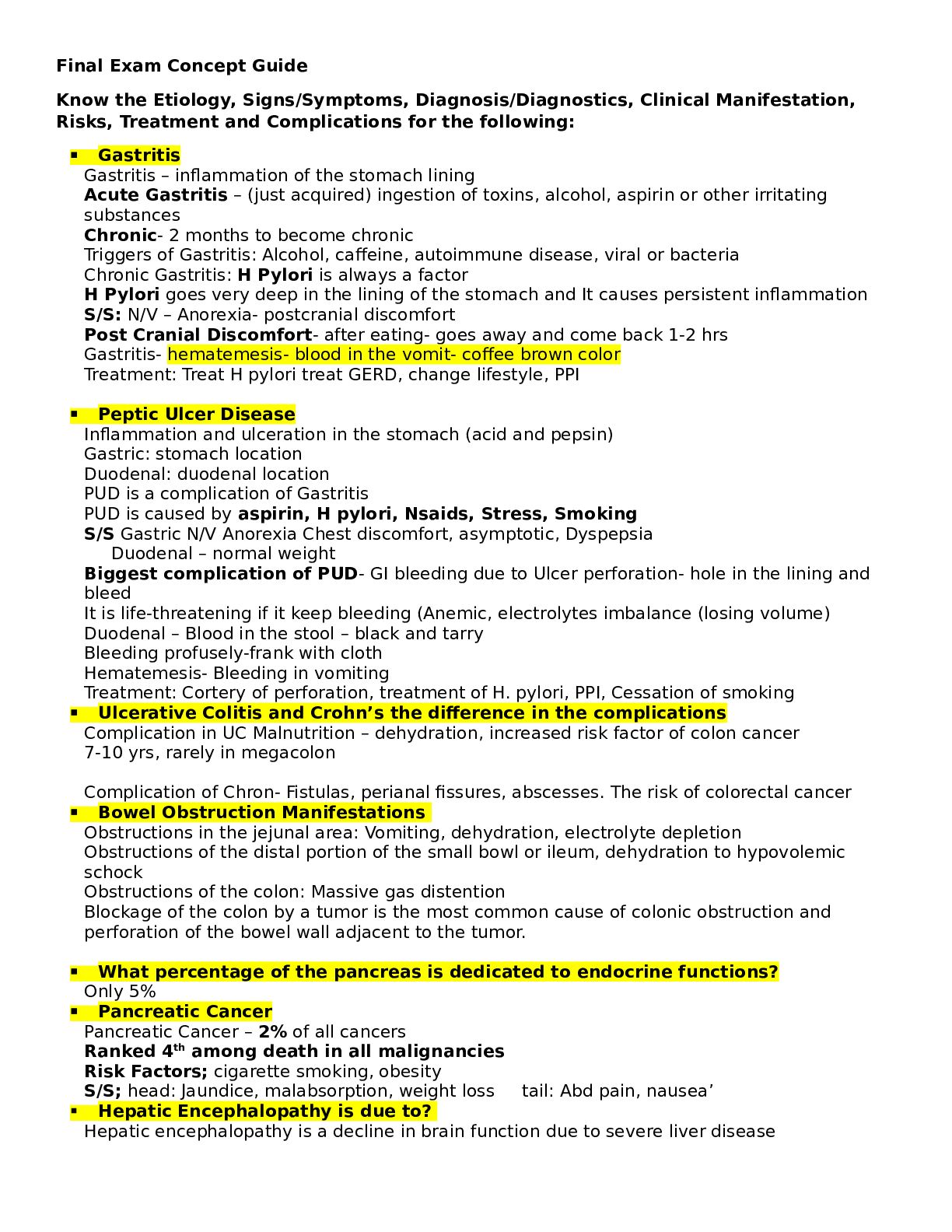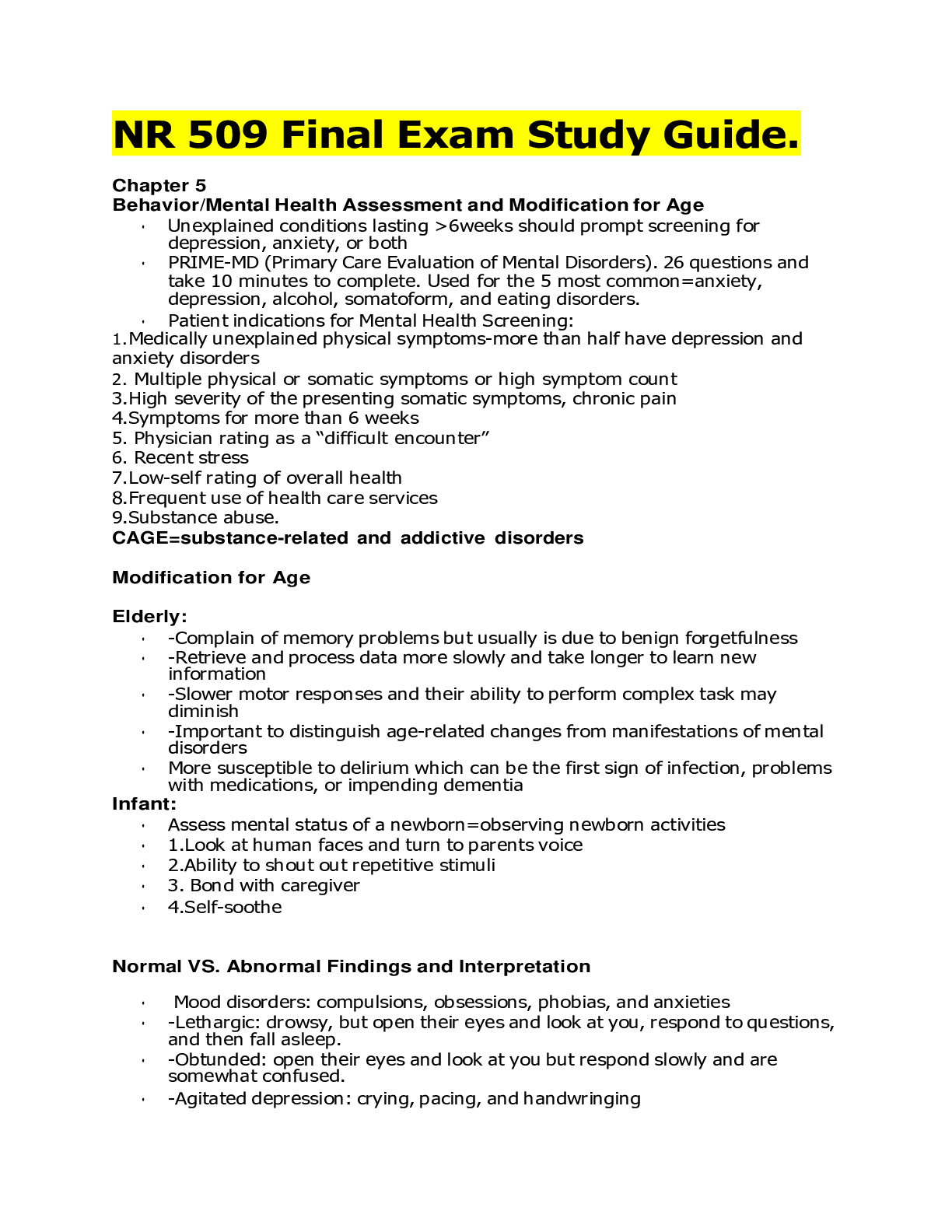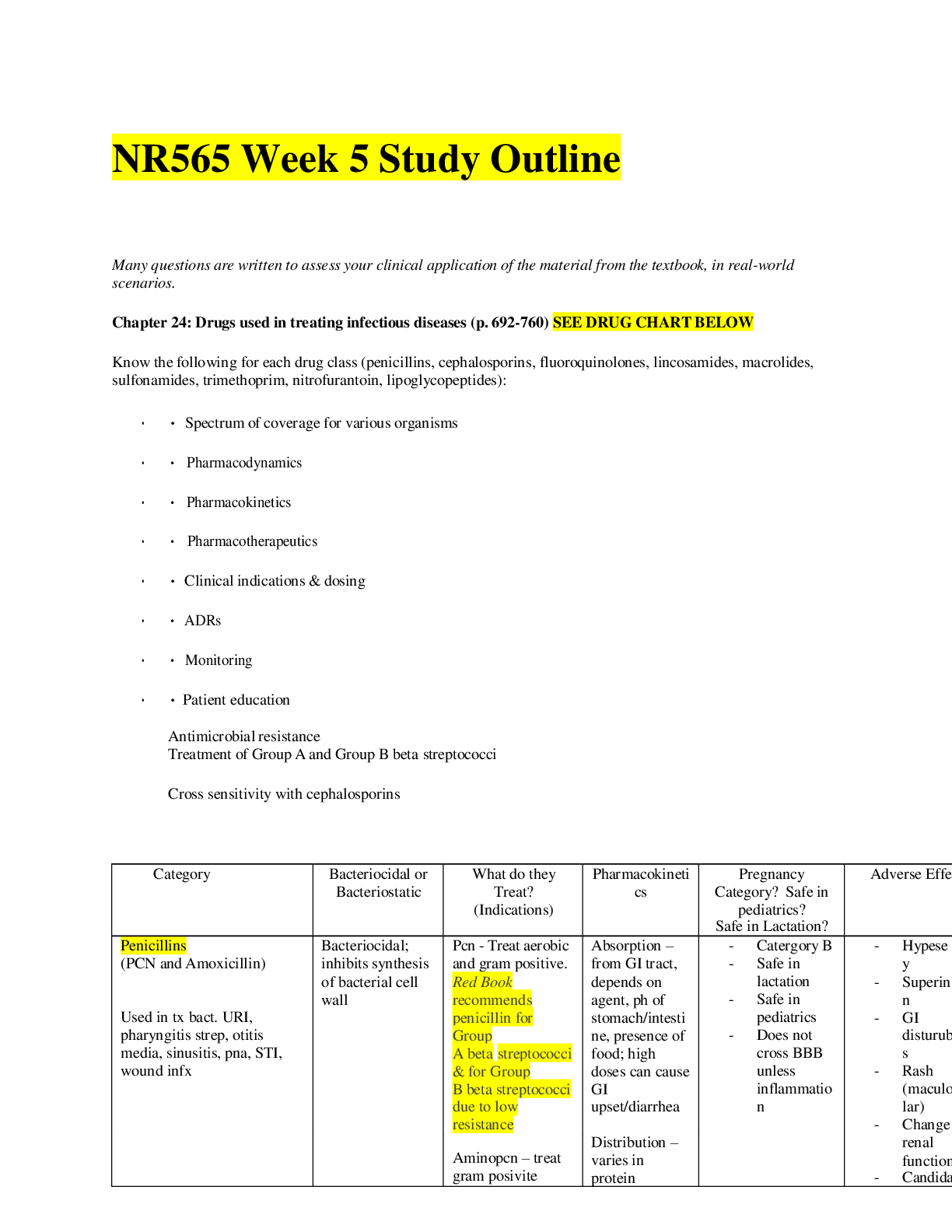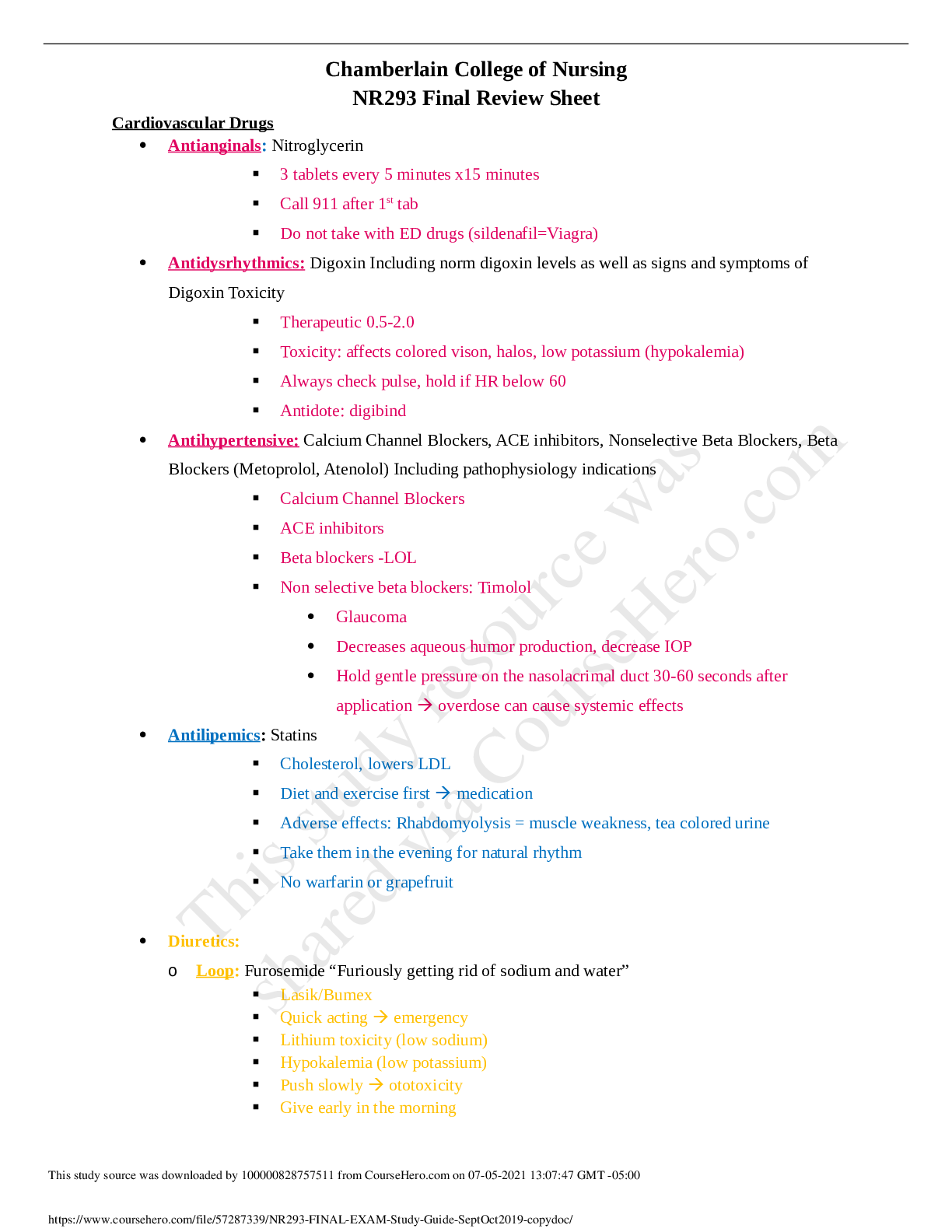*NURSING > Final Exam Review > NURS 6531 Final Exam Study Guide; New Updated Complete Solution; Walden University, 2019/2020. (All)
NURS 6531 Final Exam Study Guide; New Updated Complete Solution; Walden University, 2019/2020.
Document Content and Description Below
FINAL EXAM STUDY GUIDE (FINALLY!!!) 1.) Hydrocele (member did not use template, no review questions received-this is all I got) Definition: an accumulation of fluid within the tunica vaginalis surro... unding the testicle; it may also result from a patent processus vaginalis at birth and sometimes closes spontaneously within the first 1 to 2 years of life. Hydroceles are the most common cause of painless scrotal swelling.; in adults they are often the result of trauma, a hernia, testicular tumor, or torsion or a complication of epididymitis. Presenting Symptoms: Usually painless and may be present for long periods, partially resolve, and recur before the patient seeks medical attention. Gradual enlargement of the scrotum occurs with marked edema, which may be uncomfortable because of the added weight. A hydrocele may occur secondary to a tumor when excess serous fluid accumulates in the scrotal sac. It will transluminate but may make testicular palpation difficult. Leik Review: Hydrocele more common in infants. Serous fluid collects inside the tunica vaginalis. During scrotal exam, hydroceles are located superiorly and anterior to the testes Most hydroceles are asymptomatic. Will glow with transillumination. If new-onset hydrocele in an adult or enlarging hydrocele, order scrotal ultrasound and refer to urologist. Differential Diagnoses: Epididymitis, Testicular torsion, epididymal cyst Review questions: 1. A patient who has had a swollen, nontender scrotum for one week is found to have a mass within the tunica vaginalis that transilluminates readily. The family nurse practitioner suspects: a.) a hydrocele. b.) a varicocele. c.) an indirect inguinal hernia. d.) carcinoma of the testis. 2.) Chronic Kidney failure: (member did not use template, no review questions received-this is all I got) Definition: The absence of kidney function. Kidney failure is also known as End Stage Kidney Disease. It is characterized by anuria and the need for renal replacement therapy or kidney transplant. The kidneys and urinary tract system no longer filter blood, create filtrate. Or excrete urine in amounts sufficient to clear waste and balance fluid intake with output. Key highlights: Proteinuria or hematuria, and /or a reduction in the glomerular filtration rate, for more than 3 months duration. The most common causes are diabetes mellitus and hypertension. Most people are asymptomatic and the diagnosis is determined only by laboratory studies. Differential diagnosis: obstructive uropathy, nephrotic syndrome, glomerulonephritis 3.) Acute tubular necrosis (member did not use template, no review questions received-this is all I got) Definition: reversible or irreversible type of renal failure caused by ischemic or toxic injury to renal tubular epithelial cells. The injury results in cell death or detachment from the basement membrane causing tubular dysfunction. A history of hypotension, fluid depletion, or exposure to nephrotic agents is usually present. In otherwise healthy individuals, when the underlying insult is corrected, the patient frequently has a good outcome with complete renal recovery. There is no specific therapy for acute tubular necrosis apart from supportive care. Differential diagnosis -Prerenal azotemia, intrinsic renal azotemia Treatment Options: There is no specific treatment apart from supportive care in maintaining volume status and controlling electrolyte and acid-base abnormalities. Nephrotoxins should be ceased or if this is not possible, dose should be decreased. Review questions: A client had excessive blood loss and prolonged hypotension during surgery. His postoperative urine output is sharply decreased, and his blood urea nitrogen (BUN) is elevated. The most likely cause for the change is acute: A) Prerenal inflammation Bladder outlet obstruction C) Tubular necrosis D) Intrarenal nephrotoxicity Which of the following is a sign or symptom of acute tubular necrosis (acute kidney injury)? answer-Thirst and increased rapid pulse symptoms of ATN can vary depending on severity. and one may have- problems waking up, feeling drowsy even during day time , feeling lethargic or physically drained, being excessively thirsty or experiencing dehydration, urinating very little or even not at all, retaining fluid or experiencing swelling in body, having episodes of confusion and experiencing nausea and vomit 4. Indirect inguinal hernia Definition: Indirect inguinal hernia – Indirect inguinal hernia is caused by a birth defect in the abdominal wall that is present at birth. A scrotal-inguinal hernia results when a segment of the bowel slips through the internal inguinal ring, where it may remain in the inguinal canal or pass into the scrotal sac. An inguinal hernia may occur as a result of a defect in the anterior abdominal wall or because of a patent process vaginalis. Inguinal hernias predominantly affect men (9:1) and have the highest incidence in men aged 40 to 59. A hernia may move freely between the abdomen and the scrotum or can be spontaneously reduced by digital manipulation. When a hernia becomes strangulated or is unreducible, this compromises the blood supply and requires emergent surgical reduction. Strangulation should be suspected when a tender mass is palpated in the scrotum in addition to redness, nausea, and vomiting Presenting Symptoms: Scrotal swelling, mild to moderate pain on straining, scrotal heaviness, and the possible presence of a bulge are common complaints. Increased edema after standing in an erect position but decreases when the patient is recumbent. 3 Differential Diagnoses: undescended testis, lymphadenopathy, femoral hernia Pattern Recognition: Enlarged hemiscrotum or a bulge in the groin area that may spontaneously reduce when the patient is supine or with manual reduction. The provider will not be able to move the fingers above the mass, which should be soft and mushy but painless unless it is incarcerated and ischemic. Scrotal hernias do not transilluminate. Auscultation of bowel sounds over the mass is significant for the diagnosis of bowel in the scrotal sac. [Show More]
Last updated: 1 year ago
Preview 1 out of 91 pages

Reviews( 0 )
Document information
Connected school, study & course
About the document
Uploaded On
Sep 22, 2021
Number of pages
91
Written in
Additional information
This document has been written for:
Uploaded
Sep 22, 2021
Downloads
0
Views
93


